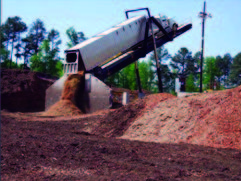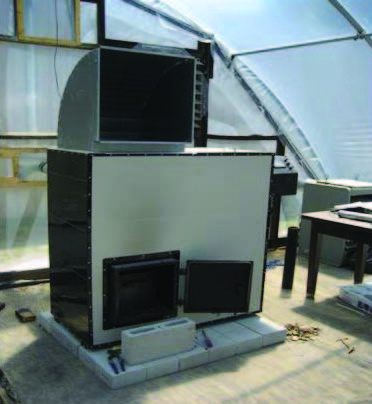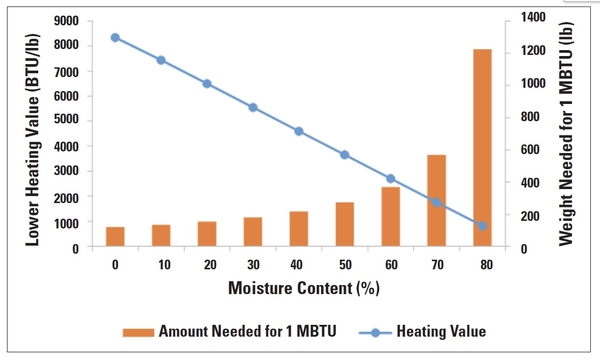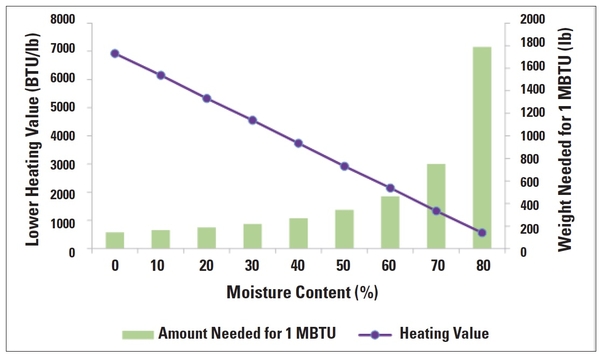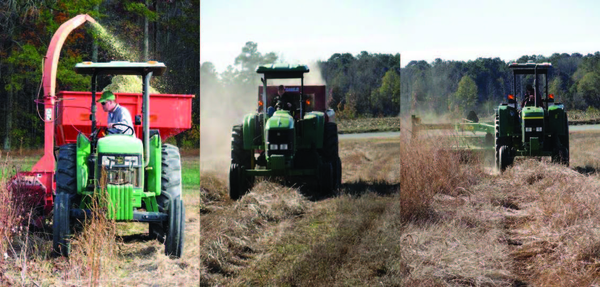An overview of biomass fuels, important characteristics for consumers to consider, and the economics of using these fuels.
North Carolina agricultural producers and many home owners consume vast quantities of nonrenewable heating fuels every year. Like all energy products, prices for heating oil, natural gas, and propane have been subject to significant increases, and the volatility of these markets continues to be a cause of concern for consumers. As an alternative to these fuels, many consumers—including farming, residential, and light industrial fuel burners—are turning to renewable biomass to meet their heating needs. North Carolina has abundant biomass resources from the forestry and agriculture sectors that can be used as alternative fuels to meet heating demands for many residential and industrial applications. This factsheet provides an overview of these fuels, important characteristics for consumers to consider, and the economics of using these fuels.
Nonrenewable Heating Fuels
Price structures and trends for energy resources are primarily tied to markets and supply trends associated with crude oil markets. When sudden volatility appeared in crude oil markets and initiated the most recent version of an energy crisis in the United States, the same rapid increases and extreme fluctuations in prices were seen in natural gas, propane, and coal markets as well. Figure 1 compares the historical residential prices of natural gas, propane, and crude oil products for 1 million Btu (MBtu) of energy. Keep in mind that the quantity required of a given fuel source to generate 1 million Btu will vary due to the differences in energy content per unit of fuel. For example, generating 1 million Btu requires 10.9 gallons of propane but 7.2 gallons of heating oil.
As the supply of petroleum has become less reliable in the United States, significant investment has been made in natural gas infrastructure, including exploration, extraction, and end-use systems. Power generation utilities have constructed several facilities throughout the United States to operate on natural gas, thereby growing demand for this fuel. The United States has large natural gas reserves, and with increased drilling, the prices have remained relatively low and stable (discounting seasonal variations). Natural gas users, however, must be located near pipelines to properly access the gas. So, although it is the cheapest heating fuel, natural gas may not be accessible to all potential users.
Renewable Heating Systems
The combustion of renewable biomass, such as plant materials, provides the greatest flexibility in terms of potential temperatures that can be achieved, the size of the material being combusted, and fuel sources (type and packaging). A variety of plant material or biomass heating sources can be used—ranging from woody material (such as wood chips, Figure 2), agronomic residues (such as cotton stalks and gin trash), or dedicated herbaceous material (such as switchgrass). Consumers need to investigate several physical properties and economic considerations when selecting a biomass fuel type for a heating application.
Five characteristics must be fully considered when making a decision about using a biomass fuel source: heating value, moisture content, ash content , emissions, and additional processing. These characteristics have to be assessed to ensure the material being evaluated will meet your heating needs. Our discussion here is limited strictly to determining the quality of the fuel source. If biomass heating is an option under consideration, additional discussion with heater and boiler manufacturers will be necessary to make sure their systems can combust a particular type of biomass.
Heating Value
Perhaps the most important characteristic of a biomass under consideration as a combustion fuel is its heating value. Heating value refers to the total amount of thermal energy released from a specific quantity of fuel when it is combusted. Common units for heating value include British thermal units per pound (Btu/lb), kilocalories per kilogram (kcal/kg), and kilojoules per kilogram (kJ/kg). Conventional, nonrenewable fuel heating values are reported per unit volume (Btu/gal or kJ/L). This value helps determine the amount of material a consumer would require to generate sufficient thermal energy to meet their heating needs. There are actually two heating values that are reported, lower heating value (LHV) and higher heating value (HHV). The major difference between the two is how each value considers the presence of water. HHV considers all of the heat energy in the fuel as well as the energy in the water vapor released during combustion (Demirbas, 1997). LHV does not include the energy contained in the water vapor, and it is always a lower value for a given fuel source. HHV is nearly always used when coal is the fuel of choice, so boiler and heater manufacturers use HHV for biomass fuel devices as well. There are a few select cases where LHV is considered, but that consideration will be manufacturer specific.
Let’s now consider a facility requiring 200,000 Btu per hour to operate a boiler (Figure 3). If the biomass stove used to heat the boiler operates on solid wood (air dried logs) with a heating value of 6,350 Btu per pound, approximately 31.5 pounds of wood are required per hour to operate the system if the system efficiency is 100%. Dividing the heating requirement (200,000 Btu/hr) by the fuel’s heating value (6,350 Btu/lb) will give the consumer the feed rate of 31.5 lb/hr.
Heating value is a highly variable value for biomass, and it can vary widely based on the amount of water in the biomass, the structural stability of the material (whether it has started to decompose), and the amount of mineral, soil, and sediment that is stored in or on the plant tissue. Figure 4 shows the typical range for biomass fuels. The exact plant composition in terms of lignin, cellulose, and sugars will also influence the heating value. Because plant composition can vary year to year based on weather variations, growing cycles, and other plant physiological phenomena, it is best to use the smaller HHV values reported for a given biomass type. Using the smaller values may lead to a slight overpurchase of biomass, but that is far better than overestimating HHV and running out of heating fuel on a cold winter day.
Heating value can be determined using an analytical device known as a bomb calorimeter. The calorimeter uses a pressure vessel known as a bomb to combust a small sample of biomass under a high-pressure, oxygen-enriched environment. After the biomass combusts and releases thermal energy, changes in temperature inside the bomb are measured. Based on this increase in temperature, we can measure the amount of energy (the heating value) contained in the combusted material. Performing on-site calorimeter readings is not necessary for most farm and residential operations as the cost to purchase and operate a calorimeter is expensive for a small-scale operation. Numerous government agencies and scholarly institutions report HHVs for common biomass fuels.
Moisture Content
Moisture content refers to the amount of water contained within a biomass sample, and it can be represented on either a wet basis or a dry basis. Wet basis moisture content is the weight of water in the material divided by the total weight of the material. Wet basis moisture content can be determined using the following formula:
Moisture Contentwet basis=Wet Weight (lb) − Oven Dried Weight (lb)Wet Weight (lb)×100%
Generally, a wet basis moisture content can be assumed in heating applications and the value cannot exceed 100%. For example, consider 100 pounds of switchgrass harvested from a field and after drying only 40 pounds of material remains. This would correspond to a moisture content of 60%. In other words, 60 pounds of the green material harvested was water, which has no value as a heating resource. The most common procedure for determining moisture content is exposing biomass to temperatures slightly above boiling for an extended period. Typically, drying the material at 221°F (105°C) for 24 hours can be used to get a dry sample for determining moisture content. Drying should be continued until the dried biomass sample achieves a consistent weight. So additional drying time beyond 24 hours may be needed.
Biomass moisture content is a critical value a consumer needs to monitor throughout the receiving, storage, and combustion process. Although the traditional method of acquiring this value is relatively simple, it is time consuming. Fortunately, a variety of electronic moisture meters can be purchased that can give near instant moisture content results (Figure 5). Generally, the accuracy and speed of measurement will improve as these electronic moisture meters increase in price. An electronic moisture meter must be designed and calibrated for the biomass material on which it will be used or readings will be inaccurate. Also, some units will operate only within specific moisture content ranges, so that is an additional purchase consideration. Regardless of the method (oven vs. electronic instrument), measuring moisture content is important.
A consumer should monitor biomass moisture content for three critical reasons:
1. Moisture content reflects the amount of water that a consumer will pay for when receiving biomass. Consider 1 ton of green wood chips with a moisture content of 50%. The consumer would be paying for 1,000 pounds of water that provides no heating value.
2. As the amount of water in the material increases, energy in the biomass will be consumed to heat and evaporate the water (Maker, 2004).
3. Excessive moisture in the biomass creates conditions ideal for microbial activity that will degrade the biomass overtime. Fungus, bacteria, and mold will start consuming the material and could create conditions for spontaneous combustion.
To illustrate reasons 1 and 2, consider Figure 6, which illustrates how moisture content affects the energy content of wood chips. The first trend is the obvious decline in LHV (also known as net heating value) as the moisture content increases. As the wood chip burns, a portion of its energy is required to evaporate the water and that portion is not usable heat. With the wetter chips, a consumer is not only stuck with having to store and burn more chips for the same amount of energy, but may pay more for them if moisture content is not discussed prior to receiving the material. Figure 7 shows a similar trend for corn stover.
The drier the biomass material, the more stable it will be in storage and the greater the heat energy that can be recovered during combustion. Because of the energy required to remove water from biomass, it is not advisable to artificially dry the product prior to combustion. Rather, harvest should be timed so crops are harvested at their driest stage. For instance, many agricultural crops achieve their highest moisture content during the summer months when they are at peak growth, so harvesting later in the year, after a killing frost, will provide a naturally drier material. Additionally, material should be sheltered from precipitation to prevent additional water from accumulating in the biomass. Finally, if the biomass material will be purchased, it is important to know the moisture content before accepting delivery. If suppliers are being paid on a weight basis (such as $/ton), they have a financial incentive to deliver high moisture content material.
Ash Content
Ash content refers to the amount of ash that remains after a material is combusted and is generally represented as a percentage of the total dry weight of the biomass before it is burned. For example, 100 pounds of switchgrass with an ash content of 12% will generate 12 pounds of ash after it is burned. Ash consists mostly of metals and minerals that cannot combust. The ash content of biomass can vary significantly, and the content can even be affected by how much soil and sediment is found on the biomass (Tortosa-Marisa et al., 2007). The most common procedure for determining ash content is exposing biomass to very high temperatures for an extended time. The US Department of Energy’s National Renewable Energy Lab calls for dry biomass to be heated at 1067°F (575°C) for 24 hours to determine ash content.
Ash content is an important value for a biomass consumer to consider because ash can become a major disposal issue as quantities increase. Typically, ash is either disposed of in landfills or applied to the land as a soil amendment, returning nutrients to the land. Land application can be a cause for concern because trace amounts of heavy metals can be found in biomass ash. In time, this could lead to soil contamination—depending on pre-existing soil levels for these heavy metals, although several studies in Finland and the United States indicate ash application poses little risk to public health (Vance, 1996; Meyers and Kopecky, 1998). As the combustion of biomass for heat energy becomes more popular, new markets for ash will likely develop. For example, numerous research groups are looking at building materials similar to concrete that are derived from biomass ash (Wang and Baxter, 2007).
It is best to select biomass materials with low ash contents to minimize disposal constraints. Small variations in biomass type can have major impacts on ash content. Wood with bark has more potential to generate ash compared to clean wood with no bark, and the exact amount of additional ash will depend on the ratio of wood to bark. Also, little can be done to lower the ash content of a particular material, so checking ash content of biomass samples on a frequent basis is not warranted in most cases. If you are concerned about excessive soil or sediment accumulation on the material, an ash content analysis in conjunction with soil sampling would expose this issue. Often woody material collected from commercial and residual developments that employ a tub grinder will have higher ash content resulting from soil collecting on the tree trunks and stumps prior to processing. Ash contents for a variety of biomass materials are readily available online.
If the correct combustion and plant composition parameters are present, ash can actually “melt” and cause problems known as slagging and fouling. Fouling involves the molten ash collecting on the sides of the combustion chamber and exhaust stack. Slagging refers to hard deposits that settle in the bottom of the combustion chamber. Generally, lower ash contents will lead to fewer problems with molten ash. Dirt and mineral content on the surface of the biomass material will also create conditions right for slagging and fouling (Ciolkosz, 2009). Many biomass heating equipment manufacturers have strategies for dealing with these problems if their equipment has been designed for a particular species of biomass.
Emissions
North Carolina’s Department of Air Quality can assist in determining if a permit is necessary, although most farm-scale applications will be exempt. If permitting is required, usually two tests called proximate analysis and ultimate analysis will have to be completed by an outside lab. A proximate analysis determines moisture content, nonvolatile carbon, volatile matter, and ash content for the biomass. An ultimate analysis takes it a step further and looks at elemental composition of the material, including carbon, hydrogen, oxygen, nitrogen, and sulfur (Gaur and Reed, 1998). These tests are fairly expensive and are necessary only if a permitting agency requires them to meet emission standards in a region or for a specific size of operation.
Additional Processing
Another important factor when considering biomass as a fuel resource concerns the level of additional processing that will be required to make use of the fuel. For instance, very limited technology currently exists in the United State to burn whole bales of hay, straw, or some other forage material. The level of processing required to burn biomass for thermal energy is highly dependent on the type of heating system in place. Examples of processing steps include drying, size reduction, and densification. Because biomass is a low density product, a consumer would need to maintain a relatively large stockpile of material to produce the energy equivalence of a natural gas or propane system. To reduce the size of a storage facility and the footprint of the stored material, densification is often used to increase the density of biomass (Fasina et al., 2006). Briquettes (Figure 8) and pellets are examples of densified biomass products that can be used as fuel resources, and these products will be more expensive than unprocessed biomass (such as woodchips or chopped switchgrass). (See Energy Pellets as a Heating Alternative, AG-785, a related publication available from N.C. Cooperative Extension.)
Material handling will ultimately have the greatest influence on how much processing is required for the biomass. The packaging of the fuel (such as solid wood logs, wood chips, or sawdust) will be determined based on the material combustion capabilities of the boiler or heater. A secondary consideration for the amount of processing is the type of equipment available to load the boiler (such as conveyors, bucket loaders, or manual labor). Excessive processing of biomass for fuel should be avoided. For example, if a boiler is approved for wood chips, then making chips into pellets would simply add cost.
Economics of Biomass Heating
At this writing in early 2013, there are essentially two ways to acquire biomass heating fuel. The material can be grown onsite for direct use or it can be purchased from a biomass supplier. Currently, the only biomass material that is readily available from private suppliers is wood chips. A discussion with your county Extension Forestry agent can provide information on where to procure wood chips in your area. Wood chips are actually a relatively low cost source of biomass energy and have been recognized as a good heating fuel for many years (Tillman, 1978). Often wood chips used for biomass heating are made from tree limbs, tops, and other woody material, so there are limited competing uses for the material. Also, the scale of the chipping operations is such that the product costs are favorable compared to many agricultural biomass sources.
When agricultural biomass is considered as a fuel resource, there will be substantial costs associated with the operation of equipment to collect and package the material for heating purposes (Bain et al., 2003). Both forage chopping and baling (Figure 9) are field operations that can be used to gather biomass. Forage chopping in general is slightly cheaper because it requires fewer passes through the field, but the chopped material must be properly ensiled to prevent decay. Chopped material is also in a more burnable form than hay bales. Baling is more expensive than chopping operations but provides a biomass package that is easy to store. Bales, however, usually require grinding to get the material into a more combustible form. The bale grinding operation can be laborious and relatively costly for a heating fuel.
Figure 10 provides the costs of biomass collection for several biomass types, and Figure 11 summarizes the costs to acquire 1 MBtu of heat energy in the form of pellets from the various biomass resources. These costs include both fixed and variable costs for the field operations, although it was assumed that other, traditional farm operations absorb most of the fixed costs. We collected these data at NC State while studying the use of these residues as heating fuels. These costs are based on what would be considered small-farm-scale operations (such as single row forage choppers, PTO powered pellet mills, < 15 hp hammer mills).
In Figure 10, switchgrass is the most expensive crop to collect, but that is because it involves a traditional hay harvest operation with multiple field passes. Other crops are single-pass operations, such as forage-chopping cotton stalks or baling sunflower stalks that are windrowed behind a combine. Figure 11 supports the use of wood chips as a significant renewable heat energy resource. Because of the abundance of wood chips, their low production cost, and their availability for purchase in bulk, wood chips are a very good source of biomass heat energy in North Carolina. The other biomass types also provide significant savings over nonrenewable forms of heat energy, but they will require greater effort to process, store, and combust than wood chips. If there are environmental concerns that constrict markets, however, or if other markets start using wood chips, then the agricultural biomass types may be more advantageous as heating resources.
Summary
Both agricultural and forestry biomass can provide adequate sources of renewable fuels that can be used in a wide array of heating applications in North Carolina. Picking a biomass resource that provides high heating values, low moisture, and low ash content is important to ensure a high-quality fuel resource. The quality of the material will have a direct impact on the performance of the heater or boiler and determine the long-term success of the system. Using materials that are too wet, produce excessive ash, or do not provide adequate heat will lead to frustration, more costs, and possibly the abandonment of biomass as a heating resource in North Carolina. In 2013, wood chips provide the most abundant and lowest cost biomass resource for use as a fuel. Regardless of the biomass fuel you plan to use, it is critical to check with your boiler or heater manufacturer to make sure the unit can burn the material and to determine the required metrics for the material—such as moisture content limits, ash content limits, and how clean the material must be (such as lack of bark, soil, or other noncombustibles).
References and Resources
Bain, R., W. Amos, M. Downing, and R. Perlack. 2003. Biopower Technical Assessment: State of the Industry and Technology (Report No. NREL/TP-510-33123). Golden, CO: National Renewable Energy Laboratory. ↲
Bushnell, D., C. Haluzok, and Dadkhah-Nikoo, A. 1989. Biomass Fuel Characterization: Testing and Evaluating the Combustion Characteristics of Selected Biomass Fuels (Report No. DOE/BP-1363). Portland, OR: US Department of Energy, Bonneville Power Administration. ↲
Ciolkosz, D. 2009. Characteristics of Biomass as a Heating Fuel (Pub. No. UB043). University Park, PA: Penn State Agricultural Research and Cooperative Extension. ↲
Demirbas, A. 1997. Calculation of higher heating values of biomass fuels. Fuel 76(5): 431–34. ↲
ERC (Energy Research Center of the Netherlands). 2013. Phyllis2 Biomass Database [Internet, Accessed 15 Aug 2013]. ↲
Gaur, S., and T. Reed. 1998. Thermal Data for Natural and Synthetic Fuels. New York: Marcel Dekker. ↲
Fasina, O. O., D. Bransby, J. Sibley, and C. Gilliam. 2006. Heating of greenhouse with biofuel pellets (ASABE Paper No. 064183). 2006 ASABE International Meeting (Portland, OR). St. Joseph, MI: American Society of Agricultural and Biological Engineers. ↲
Jenkins, B. 1993. Properties of biomass (Appendix). In Biomass Energy Fundamentals (EPRI Report No. TR-102107). Palo Alto, CA: Electric Power Research Institute. ↲
Jenkins, B., L. Baxter, T. Miles Jr., and T. Miles. 1998. Combustion properties of biomass. Fuel Processing Technology 54: 17-46. ↲
Maker, T. 2004. Wood Chip Heating Systems: A Guide for Institutional and Commercial Biomass Installations. Montpelier, VT: Biomass Energy Resource Center. ↲
Meyers, N. L., and M.J. Kopecky. 1998. Industrial wood ash as a soil amendment for crop production. Tappi journal, 81(4), 123-130. ↲
Tillman, D. A. 1978. Wood as an Energy Resource. New York: Academic Press. ↲
Tortosa-Marisa, A., R. Buhre, R. Gupta, and T. Wall. 2007. Characterizing ash of biomass and waste. Fuel Processing Technology 88(11): 1071–81. ↲
US Department of Energy. 2011. Biomass Energy Data Book. 4th edition. Oakridge, TN: Oakridge National Laboratory. ↲
US Energy Information Administration. 2013. Monthly Energy Review [Internet, Accessed 14 Aug 2013]. ↲
Vance, E. D. 1996. Land application of wood-fired and combination boiler ashes: an overview. Journal of Environmental Quality, 25(5), 937-944. ↲
Wang, S., and L. Baxter. 2007. Comprehensive study of biomass fly ash in concrete: strength, microscopy, kinetics and durability. Fuel Processing Technology, 88(11), 1165-1170. ↲
Prepared by
Matthew W. Veal, Assistant Professor and Extension Specialist
William G. Brown, Graduate Research Assistant
Department of Biological and Agricultural Engineering
NC State University
Photographs by M. W. Veal and W. G. Brown
Publication date: Nov. 11, 2014
Reviewed/Revised: June 28, 2024
AG-783
N.C. Cooperative Extension prohibits discrimination and harassment regardless of age, color, disability, family and marital status, gender identity, national origin, political beliefs, race, religion, sex (including pregnancy), sexual orientation and veteran status.


